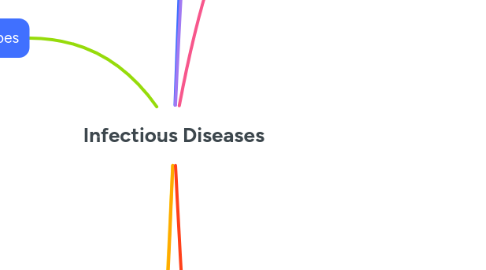
1. Microbes
1.1. Impact on Humans
1.1.1. Cholera
1.1.1.1. Thrives in unsanitary water, caused at least 7 pandemics with tens of millions of deaths
1.1.2. Ebola
1.1.2.1. Regular outbreaks since discovery
1.1.2.2. Past mortality rate before proper funding and treatment: 90%
1.1.2.3. After proper care and funding, mortality rate has dropped to about 50%
1.1.3. Influenza
1.1.3.1. Hit in 1918, where life expectancy at its worst was less than the age of 40
1.1.3.2. Over less than 100 years since its outbreak, life expectancy has raised about 30 years
1.1.4. Smallpox
1.1.4.1. Only resides in human host
1.1.4.2. Large vaccination campaign organized by WHO brought the final case in 1977
1.1.4.3. Only active virus kept tightly secure in protected facilities
1.2. Antibiotic Resistance
1.2.1. Funding severely dropped in 1970, went more towards non-communicable diseases
1.2.2. 1980 HIV/AIDS discovery
1.2.3. 2002-2003 SARS outbreak
1.2.4. Bacteria evolve resistance to many treatments
1.2.5. Named one of the top 10 public health threats
1.3. Types of Microbes
1.3.1. Acellular (Non-living)
1.3.1.1. Prion
1.3.1.1.1. Misfolded/aggregated proteins that spreads from protein to protein that cause diseases (esp. neurodegenerative)
1.3.1.1.2. No DNA or RNA
1.3.1.1.3. Fibrils: chains of aggregated proteins
1.3.1.1.4. Cells unable to function
1.3.1.1.5. Resistant to standard sterilization procedures
1.3.1.2. Virus
1.3.1.2.1. Infectious agent that can multiply in living host cells
1.3.1.2.2. Inactive outside host
1.3.1.2.3. Nucleic genome housed in protein coat
1.3.1.2.4. Infect all life forms
1.3.2. Cellular (Living)
1.3.2.1. Bacterium/Archaeon
1.3.2.2. Eukaryote
1.4. Where are microbes?
1.4.1. Found in extreme environments (e.g. Deep sea, salt-rich, heat, etc.)
1.4.2. In animal bodies (many positive/neutral for our health)
1.4.3. Aids with decomposition and carbon cycling in nature
1.5. Important for:
1.5.1. Oxygen: Early bacterial photosynthesis generated oxygen and lead to species explosion
1.5.2. Agriculture: Bacteria fixes nitrogen to be used by other plants and animals, helping in evolution
1.5.3. Food production: Decomposition of microbes in cheese, beer, fermentation in chocolate-making, cultured milk, etc
1.5.4. Biotechnology: Bacteria (e.g. E.coli) used to clone DNA and make discoveries
1.5.4.1. Insulin produced using recombinant DNA technology in bacteria or yeast
1.5.5. Commercially Valuable Chemicals: MSG uses grown cultures of bacterium Corynebacterium glutamicum
1.5.6. Coolant, dry cleaning, oil spills, contaminated water, bio remediation
2. Infectious Disease
2.1. An infection (colonization by pathogens in the body) that prevents it from functioning as normal
3. Communicable Disease
3.1. Infectious disease able to transmit from one host to another
4. Challenges
4.1. Emergence and re-emergence of diseases brought upon by modern living
4.1.1. Globalization
4.1.2. Overpopulation
4.1.3. Migration
4.1.4. Climate Change
4.1.5. Social Inequality
4.1.6. Etc.
4.2. The Health Gap
4.2.1. Communicable disease prevalent as main cause of death in low-income countries, but not so much in high-income countries
4.2.2. Due to differences in ethnicity, gender, disability, social status, income, sexual orientation
5. Microbiology
5.1. Studies have led to
5.1.1. Vaccine development
5.1.1.1. Many more people living in their midlife, causes of death shifting toward the elderly
5.1.2. Antibiotic discovery
5.1.3. Public health infrastructure
5.1.3.1. Better sanitation, clean water
5.2. The study of organisms that are too small to be seen without a microscope
6. Germ Theory
6.1. Pre-germ theory: Miasma theory
6.1.1. Diseases caused by poisonous emanations from carcasses, rotting vegetation, dust particles
6.2. Microbe Discovery
6.2.1. 5th century: Jain scriptures - nigodas: small creatures in clusters with short lives
6.2.2. 1400s: Akshamsaddin - diseases have insivible seeds
6.2.3. Antonie Van Leeuwenhoek: designed microscopes, first to see microbes
6.2.4. Ignas Semmelweis: Realized different mortality rates in doctor vs. midwife clinic
6.2.4.1. Doctors attending to baby deliveries without washing after other operations
6.2.5. Agostino Bassi: Silkworms - fungal spores from infected worm placed on non-infected worm led to it becoming infected, suggesting transmission
6.2.6. Louis Pasteur: Disproved spontaneous microbe generation
6.2.6.1. Used experiment to prove that air nor broth alone were sufficient for microbes to grow
6.2.6.2. Led to theory of biogenesis
6.2.6.3. Developed rabies and anthrax vaccines
6.2.6.4. Developed food and milk pasteurization
6.2.7. Joseph Lister: Antiseptic surgery - discovered microbes responsible for pus in wounds
6.2.7.1. Used carbolic acid to treat wounds and prevent infections
6.2.7.2. Sterilize instruments, clean operating room
6.2.8. Robert Koch: Discovered causes of anthrax, chloera, TB
6.2.8.1. Koch's Posulates
6.2.8.1.1. 1. Microbe must be found in all organisms with disease, not in healthy ones
6.2.8.1.2. 2. Microbe must be isolated from diseased organism and grown in pure culture
6.2.8.1.3. 3. Cultured microbes should cause disease when introduced into healthy organism
6.2.8.1.4. 4. Microbe must be isolated again from newly diseased organism and be identical to original microbe
7. Medical Microbiology
7.1. Study of microbes that cause disease (PATHOGENS)
7.2. Organism Classification
7.2.1. More recently 2 domains instead of 3
7.2.1.1. Bacteria
7.2.1.1.1. Rigid cell wall called peptidoglycan
7.2.1.1.2. Single celled
7.2.1.1.3. Multiply by binary fission
7.2.1.1.4. Coccus (round), Rod, Vibrio (curved), Spirillum (squiggly), Spirochette (spiral) shapes
7.2.1.2. Archaea (Prokaryotes)
7.2.1.2.1. Eukaryotes
7.2.1.2.2. No peptidoglycan in cell walls
7.2.1.2.3. Ribosome more similar to eukaryotes
7.2.1.2.4. Transcription closely resembles eukaryotes
7.2.1.2.5. Different lipids in membrane
7.2.1.2.6. rRNA sequence divergence: Motivation for separating Archaea from Bacteria
7.2.1.2.7. Live in extreme conditions (e.g. Acid mines, hot springs, etc)
